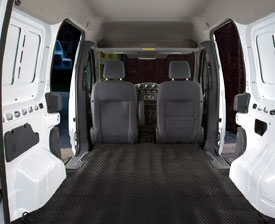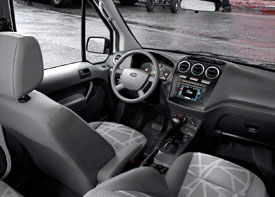2010 Ford Transit Connect
Ford Motor Company is the only U.S. automaker to avoid bankruptcy. But they’re by no means assured of long term success. Part of their plan to prosper hinges on bringing their best overseas vehicles here. First to arrive is the Transit Connect van. Since 2003, some 600,000 Transit Connects have been sold in 58 countries. Its compact size appeals to small businesses. But will it connect with American entrepreneurs? Well, let’s load up and find out.
The 2010 Ford Transit Connect does indeed look narrow and quirky by American work van standards. But this Turkish-made front-wheel drive hauler is clearly a Ford truck- from the sharp-edged headlight stacks and understated three-bar grille to the F-150-style stepped front windows and side mirrors.
Even in top XLT trim, work-grey fender flares surround no-nonsense 15-inch steel wheels with plastic lug-nut covers. But, while styling won’t raise any pulses, the Transit Connect’s form follows its function to a ‘T.’
Indeed, the most striking feature is its short but tall proportions. With a wheelbase of 114.6 inches, it’s only 180.6 inches long overall. That’s three feet shorter than Ford’s E-Series full size van. But at 79.3 inches tall, it’s more than 10 inches taller than Ford’s last minivan, the Freestar.
That makes it ideal for small businesses that carry bulky items, like the tasty creations from our friends at Baltimore’s Charm City Cakes.
MARY ALICE YESKEY: We got the Ford Transit about six months ago, and the whole experience was really cool for us because it was truly custom made from start to finish. We couldn’t have designed a better vehicle to transport cakes. It’s awesome.
 There are two body styles. The base cargo Van has no glass aft of the B-pillars, but windows can be added in the twin sliding side doors, the rear swing doors, or both. Optional are 255-degree split rear cargo doors with rubber bump stops.
There are two body styles. The base cargo Van has no glass aft of the B-pillars, but windows can be added in the twin sliding side doors, the rear swing doors, or both. Optional are 255-degree split rear cargo doors with rubber bump stops.
In passenger Wagon form, windows are standard and seating is available for two, four, or five.
There’s an impressive 78.1 cubic feet of cargo space behind that second row. But fold it up, or don’t tick the option box, and that figure swells to 135.3 cubic feet. Payload capacity is a more than adequate 1,600 pounds.
The driver’s space is also work-focused: bland but roomy. There are echoes of Ford’s first-gen Focus here, with which the Transit Connect shares platform components.
Our XLT came with an in-dash computer featuring navigation, Internet access, Bluetooth, and wireless keyboard; perfect for staying in touch with the office.  And above the windshield there is a useful storage shelf. Given the van’s limited rear visibility, the reverse-sensing system is another good choice.
And above the windshield there is a useful storage shelf. Given the van’s limited rear visibility, the reverse-sensing system is another good choice.
While most Transit Connects abroad use diesel power, we’ll have to make do with a gasoline 2.0-liter I4 with 136 horsepower and 128 pound-feet of torque. Our only transmission is a four-speed automatic. Still, Government Fuel Economy ratings are fine at 22 city, 25 highway. We managed 23.6 miles per regular gallon in mixed driving.
But the economy comes with a price. The Transit Connect strolls to 60 mph in 12.1 seconds, and covers the quarter-mile in 18.7 seconds at just 75 miles per hour. So, plan your merging and passing well in advance. On the other hand, 60 to 0 stops averaged an acceptable 129 feet, with a solid response.
Our van had optional Roll Stability Control. So, even with a simple torsion beam rear suspension, our Transit Connect felt light on its feet and never top-heavy through the slalom. Add in a tight 39-foot curb-to-curb turning diameter and the result is an easy-to-maneuver city hauler.
The base Transit Connect van starts at $21,475. The wagon begins at $21,830. Our well-equipped wagon ticketed for just under 25 grand. An electric-powered version will be coming to the States in 2010.
The 2010 Ford Transit Connect impressed us with its cargo space, efficiency, city-smart agility, and very useful, very cool job-site gadgets. And if the Transit Connect is a true indication of how other off-shore Fords will take to America, the company’s fortunes are bound to keep improving.
Specifications
- Engine: 2.0-Liter I4
- Horsepower: 136
- Torque: 128 Lb Feet
- 0-60 MPH: 12.1 Seconds
- 1/4 Mile: 18.7 Seconds @ 75 MPH
- 60-0 MPH: 129 Feet
- EPA: 22 MPG City/ 25 MPG Highway
- Mixed Loop: 23.6 MPG
2024 Polestar 2
More Range And More Power For The Polestar 2
Volvo is well on their way to making the transition to an all-electric brand, but their sister-brand Polestar is already there. Now, we’ve spent lots of time in their all-wheel drive, five-door Polestar 2, having tested it in 2021, and a year later when a two-wheel drive version arrived. But, EV updates are coming quickly. So, let us be your guide for all that’s new with the Polestar 2.
While we are driving more EVs than ever, we’ve also been spending a lot of time recently circling back to ones we’ve previously tested. As in this new era of electrified vehicles, significant updates are arriving quickly, with R&D investments increasing and retrofitting them easier than ever. This is often done through software updates that can even be accomplished over the air. For 2024, the Polestar 2 has indeed gotten some software updates, but some physical ones as well.
Clearly aimed directly at Tesla’s Model 3 when it arrived; the Polestar 2’s build quality was vastly better, but range definitely came up short. So, addressing that was priority No. 1; and for ’24 the Polestar can travel up to 20% farther than before while consuming 9% less energy, and when it comes time to charge it back up, it can do that 34% faster too.
Range in the Single Motor version increases from a max of 270 to 320 miles thanks to a larger 82-kWh battery pack, and that solitary motor now powers the rear wheels, not the front wheels. It’s also bigger, coming in at 220 kW compared to the previous 170 kW front-wheel drive version, going from 231 to 299 horsepower.
Dual Motors keep the same 78-kWh battery, but still sees a boost from 260 to 276 miles and takes advantage of the larger rear motor for a new combined 310-kW output with 421 horsepower. Our test car has the added Performance Pack, which uses an additional 35 kW to deliver 455 horsepower and 546 lb-ft of torque, though max range drops to just 247 miles.
The new battery in rear-drive 2s will also charge faster, now accepting up to 205 kW for an 80% charge in 20 minutes; max for dual-motors stays at 155 kW, which puts an 80% charge at 34 minutes. Using 32 kWh of electricity per 100 miles, the Dual Motor earns a good efficiency rating.
The [Polestar] 2 has always been one of the most enjoyable EVs to drive, even more so now with that additional power coming from the rear motor.
Unfortunately, extremely cold temperatures kept us from seeing that increased range, as we were only on pace for about 194 miles in our test.
The 2 has always been one of the most enjoyable EVs to drive, even more so now with that additional power coming from the rear motor. And especially when equipped with the Performance Pack as it not only includes more power, but adds 20-inch forged wheels, upgraded brakes, and adjustable Ohlins Dual Flow Valve performance dampers. It greatly improves handling prowess without affecting ride quality, and is easily worth the $5,500 charge if you at all enjoy driving.
Even on a 20-degree track day there was plenty of grip through our handling course. No understeer or oversteer, and lots of feedback through the wheel. There was a nice, strong launch off the line that properly planted us firmly in the seat, and rocketed us to 60 in 4.5 seconds. Power delivery stayed pretty intense up until about 80 mph when there was a definite tapering off. Still, it was a 13.4-second quarter-mile at 102 mph; smooth, quiet, and stable the whole way.
When this car debuted, its Google-based infotainment setup was a novelty, but since then, more and more manufacturers are just “Googling it” so it doesn’t seem out of place at all. The wireless phone charger is easy to access, and there’s a great Harmon/Kardon sound system and panoramic sunroof to enhance the in-cabin experience. Exteriors have also been enhanced with a smooth grille insert and new wheel choices.
Hatchback practicality means 14.3 cu-ft of easy to access cargo space with split-folding seatbacks for longer items and expanding the space to 38.7 cu-ft. Plus, there’s even a sizeable storage bin up front under the hood.
Single Motor Polestar 2 pricing now starts at $51,300, with Dual Motors starting at $56,700; topping out at $64,400.
For a car manufacturer that hasn’t even been around for a decade yet, Polestar has kept itself busy, totally transforming their latest model in just a few years, making the 2024 Polestar 2 even more appealing. They are certainly off to a good start, and with a host of Polestars just over the horizon, including some all-important utility vehicles, this star will be shining even brighter.
Specifications
As Tested
- Motor Setup: Dual Motor
- Horsepower: 455
- 0-60 mph: 4.5 seconds
- EPA Range: 247 miles
- Efficiency : 32 kWh / 100 miles
- Battery Size: 78-kWh
- Torque: 546 lb-ft
- 1/4 Mile: 13.4 seconds at 102 mph
- MW Test Loop: ~ 194 miles
- Peak Charging Rate: 155 kW











































